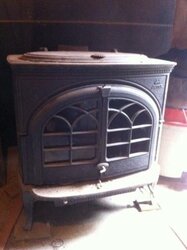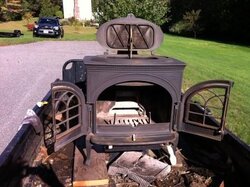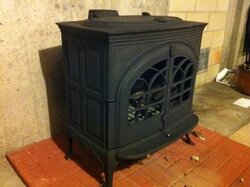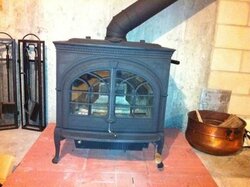raybonz
Minister of Fire
Thanx for posting that Bart I think this is the exact info Burnit13 needs to read! The tunnel through the coals makes total sense maybe I will try this on the T-5 sometime.
Ray
Ray
I think you misread Barts post Todd.. He places the wood tight to the back EW with the coals forward then creates a tunnel from the front to the wood and places a small split in the front. He then gets the stove up to temp and reduces the air or something that line..I don't understand why you would want a tunnel under the load to the back? Wouldn't that allow air to the back splits that you don't want burning til the front splits are done? I always raked the coals forward, packed it tight in back and it would slowly burn from front to back.
Ok, so the tunnel is only through the coal bed and doesn't continue all the way to the very back? I can see that, it would help get that front part going quicker.I think you misread Barts post Todd.. He places the wood tight to the back EW with the coals forward then creates a tunnel from the front to the wood and places a small split in the front. He then gets the stove up to temp and reduces the air or something that line..
Ray
Yup that's what I understood..Ok, so the tunnel is only through the coal bed and doesn't continue all the way to the very back? I can see that, it would help get that front part going quicker.

I'm daydreaming a little bit but here goes....
I bought and installed an Englander 30 in 2010 to try to beat the heating bill. I am happy to say it has saved us a lot of money on heating costs. The problem, if you can even call it that, is that my house gets TOO HOT!
I think our 115 year old 1600sqft house is tighter than I originally thought. The 30NC does not like to run low and slow so even when its pumping out 550 degrees during the coldest winter night our house gets a little too warm.
I need a low and slow stove that won't be a pollution factory like when a secondary stove is turned down too low. What I want is a cat stove. Low heat when needed and 12-24hr burn times.
I would love a Blaze King Princess or Chinook 30 but those are way over our price range. Is there an affordable cat stove out there that is actually a good stove?
The Englander 30 is the industry standard of affordable secondary stoves that actually perform well. Is there a Catalytic equivalent?
Thanks!
To put things in perspective I recently purchased a Jotul Firelight 12 for $20...
Where's the guy from last week who had trouble accepting he might get less than $1500 for his parents' used Firelight 12?
To put things in perspective I recently purchased a Jotul Firelight 12 for $20, and after putting in 10 hours of work and $500 in parts I have a beast of a stove. This is my first experience with a catalyst, so a lot of learning to still be done, but already I'm amazed with the amount of heat it puts out and the burn time with a relatively small load. Looks great, and is far superior to anything new that can be had close to that price.

Wow Score! Congrats
After lots of experimenting the last half of last season and so far this year I am burning it E/W. The key is in the stoves manual. I load it tight E/W about two thirds of the firebox with the splits approximately even with the top of the brick retainers. But this is after pulling the coal bed forward where it covers the front half of the firebox floor. Then I, as stated in the manual, take the poker and make a two inch trough front to back through the coal bed. After packing the back two thirds of the firebox I lay a small split on the coal bed in front of the load and let it get up to 400 and cut the air back a third, another third at 500-550. And the bad boy inches up to 600 during off-gassing and settles back to 500-550 for a long, long time.
Next morning if it is gonna be a sunny day or in the fifties I load three medium splits N/S on the coals pulled all the way to the front and cigar burn'em down and let is go out. Usually three or four hours later and it gives off soft heat most of the afternoon.
The key to the night load is that trough up the middle. Cooks the gases out of the wood and they burn on top of the wood long and low. Pretty much the same way a cat burns'em.

This is for sale in the Albany NY area I think it is the guy who posted the other day about his parents stove
http://albany.craigslist.org/app/3434096926.html
or this one:
http://albany.craigslist.org/hsh/3434048119.html
 .
.Man that stove is worth more than that in scrap iron! Great deal and work on your part!To put things in perspective I recently purchased a Jotul Firelight 12 for $20, and after putting in 10 hours of work and $500 in parts I have a beast of a stove. This is my first experience with a catalyst, so a lot of learning to still be done, but already I'm amazed with the amount of heat it puts out and the burn time with a relatively small load. Looks great, and is far superior to anything new that can be had close to that price.
Have you posted pics?I think I got really lucky. For the look, quality, and heating capacity I can see someone shelling out some serious cash for a firelight 12, especially if they don't want to put any sweat equity into it. I'm at the point now, where I don't think I'd sell mine for $1500, just because I don't know what I'd replace it with that I'd like better. I'm sure there are really good values out there, so I'm not implying that the open market value for this stove is that high, I just really like the design.
Have you posted pics?
Ray





